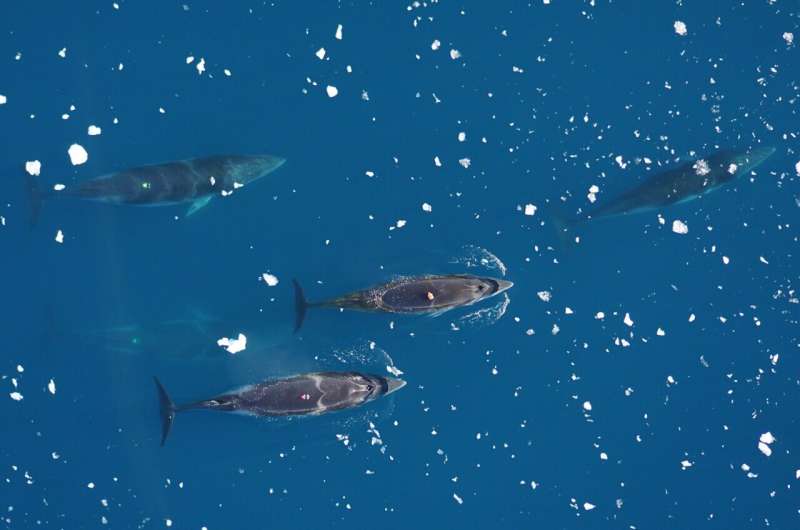This article has been reviewed according to Science X's editorial process and policies. Editors have highlighted the following attributes while ensuring the content's credibility:
fact-checked
peer-reviewed publication
trusted source
proofread
Camera tags capture social flexibility of Antarctic minke whales

Researchers have conducted one of the first quantitative studies of social structure and social foraging in Antarctic minke whales, using pioneering animal-borne camera tags.
This study
, published in Behavioral Ecology and Sociobiology, sheds light on the complex social and
The study was led by Dr. Jenny Allen as a Griffith University Research Associate in collaboration with the University of California Santa Cruz (UCSC). Data were collected in 2018 and 2019 around the Western Antarctic Peninsula as part of a research grant from the National Science Foundation's Office of Polar Programs to Dr. Ari Friedlaender, a Professor in UCSC's Ocean Sciences Department.
The study is unique in its use of motion-sensing, video- and audio-recording tags deployed on Antarctic minke whales for the first time to study their ecological role through analysis of their diving, foraging, and social behaviors.
Data analyses focused on the whales' diving, foraging, and social behaviors, providing fresh insights into their ecological roles.
Findings from the study indicated that Antarctic minke whales exhibit a "fission–fusion" social structure, frequently switching companions.
This social flexibility is similar to what is seen in several other baleen whale species. In 60.6% of cases, whales were observed forming short-term associations, engaging in both foraging and non-foraging activities.
Larger individuals were more likely to socialize, and this social interaction correlated with a noticeable reduction in their feeding efforts, regardless of dive depth.
Furthermore, the study documented 12 instances where tagged whales associated with each other in pairs or trios.
These groups demonstrated synchronized spatial movement and diving behaviors, suggesting that Antarctic minke whales employed group foraging strategies.
Specifically, 67.5% of associated dives and 64% of associated feeding lunges were synchronized.
"These findings provide essential baseline information on the sociality and group foraging behaviors of Antarctic minke whales," Dr. Allen said. "Understanding these patterns is crucial, especially as climate change continues to impact the Antarctic ecosystem."
The study underscored the importance of Antarctic minke whales as top krill predators, highlighting their role within the ecosystem.
The synchronized foraging behavior observed suggested these whales might optimize their feeding efficiency through cooperation, a behavior previously underappreciated in this species.
"This study is fascinating because it provides new information on complex and dynamic social and behavioral patterns by an animal that until now we had very little information about," says Dr. Friedlaender, the senior investigator on the project.
This research not only enhances our understanding of Antarctic minke whale social and foraging ecology but also encourages the need for future studies aimed at more targeted investigations.
More information: Jenny A. Allen et al, Evidence of sociality and group foraging in Antarctic minke whales (Balaenoptera bonaerensis), Behavioral Ecology and Sociobiology (2024). DOI: 10.1007/s00265-024-03481-4
Journal information: Behavioral Ecology and Sociobiology
Provided by Griffith University




















